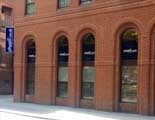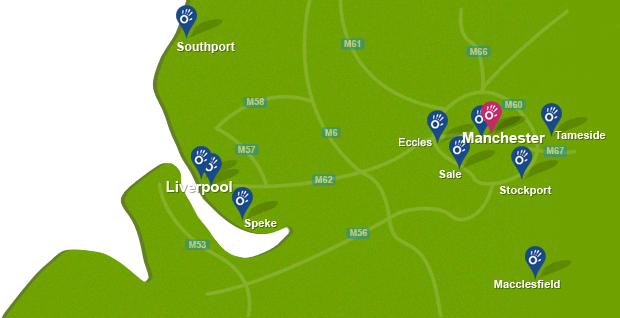The patella tendon is the continuation of the quadriceps tendon that runs centrally over the front of the knee cap and attaches the quadriceps (thigh muscle) to the top of the tibia (shin bone) The patella tendon is a very thick and strong band that primarily assists in straightening the leg and therefore endures a high amount of force from the contracting quadriceps.
Injury to the patella tendon can result in either a partial tear or a complete rupture. Both a partial tear and rupture of the patella tendon can occur when there is a violent force exerted by the contracting quadriceps muscle (i.e. when landing from a jump). Rupture of the patella tendon can cause a significant loss in function of the knee and further cause the inability to straighten the leg.
A patella tendon injury can be treated non-operatively, but only in the case of a partial tear where the patient is still able to maintain active function in the knee. A partial tear can be treated conservatively with a specific physiotherapy programme and immobilisation until the tendon has sufficiently healed. Operative management is essential in the case of a complete rupture.
Surgical repair of the ruptured tendon should be done as soon as possible after the injury but in some cases can be delayed for up to a week to allow a decrease in swelling and reduce the risk of other complications. Initially, the surgery consists of cutting out the torn edges of the tendon. This is then followed by the surgeon suturing (stitching) the torn tendon edges back together or attaching the tendon back to the bone after constructing bone tunnels in the either the patella (knee cap) or tibia (shin bone). With severe ruptures the surgeon may decide to replace the patella tendon with a reconstructed graft, either the patient’s own (autograft) or a donor (allograft). If reconstruction of the patella tendon is required then part of the hamstring tendon or Achilles tendon can be used.
After suffering from a ruptured patella tendon, it is essential to undergo surgical repair to regain the function in the knee joint. Patella tendon repair surgery will also reduce pain, increase stability and prevent the likelihood of future problems in the knee joint such as degenerative arthritis.
 Above: Patella mobilisations performed by MSK Physiotherapist
Above: Patella mobilisations performed by MSK PhysiotherapistPhysiotherapy before patella tendon repair
After suffering from a patella tendon rupture you may undergo patella tendon repair immediately however in some cases, surgery may be delayed for between 4 and 7 days so that the tendon is in an optimal condition for surgery. If surgery is delayed then your injured knee will be immobilised until your patella tendon is repaired. The aim of physiotherapy prior to patella tendon surgery is to strengthen your other joints such as your hip and ankle in your injured leg as well as strengthen and maintain movement in your uninjured leg to ensure maximum support for your damaged knee after surgery.
 Above: Soft tissue massage of the connective tissue around the patella and knee joint
Above: Soft tissue massage of the connective tissue around the patella and knee jointSymptoms after patella tendon repair
Once you have undergone your patella tendon repair, you will experience pain, stiffness, swelling and limited range of movement in your knee. Your knee will be immobilised using a knee brace and you will be given elbow crutches so you can partially weight bear as tolerated. You will be unable to drive for up to 6 weeks post surgery.
 Above: Mobilisations of the knee joint during an assessment by a MSK therapist
Above: Mobilisations of the knee joint during an assessment by a MSK therapistPhysiotherapy after patella tendon repair
Physiotherapy after a patella tendon repair is imperative to ensure the success of the surgery. A comprehensive physiotherapy programme with Physio.co.uk will guarantee the return of full or near to full function in your knee and help prevent the likelihood of any problems and further injuries to your knee in the future. Due to the severity of a patella tendon rupture and its diminishing effect on knee function, rehabilitation can be lengthy and it can take well over 6 months to recover. However, this time can be shortened significantly with appropriate commitment to your physiotherapy course with Physio.co.uk.
 Above: Patella mobilisations performed by MSK Physiotherapist
Above: Patella mobilisations performed by MSK Physiotherapist1-2 weeks
In the initial stages of your recovery after a patella tendon repair the main aims of your physiotherapy with Physio.co.uk will be to control any pain and swelling you will be experiencing, maintain mobility of the patella (knee cap), maintain strength of hip and ankle joints in your injured leg and maintain strength of the muscles in your opposite uninjured leg. Activities included in your physiotherapy programme at this stage will include:
- Crutch training
- Partial weight bearing exercises
- Pain modulation
- Cryotherapy (ice)
- Elevation
- Protection of knee using a knee brace
- Isometric hamstring strengthening exercises of injured leg
- Strengthening exercises for hip, ankle and muscles in opposite leg
- Light patella mobilisation
- Passive (assisted) range of movement exercises
2-4 weeks
After first few weeks of recovery the goals of your physiotherapy with Physio.co.uk will be to continue to reduce pain and swelling, progression of partial weight bearing, maintaining patella mobility, maintaining and increasing strength in hamstrings as well as uninjured leg. Finally, depending on your rate of recovery so far, during this stage your physiotherapy programme will now include an introduction to gentle quadriceps retraining. Activities will include:
- Crutch training with partial weight bearing
- Ice and elevation
- Protection and compression using a knee brace
- Strengthening exercises for hamstrings
- Strengthening of muscles in ankle, hip and uninjured leg
- Gentle patella mobilisation
- Active assisted range of movement exercises and passive range of movement exercises
- Gentle, isometric quadriceps strengthening exercises for injured leg
4-6 weeks
After the first month of your recovery, your physiotherapy programme with Physio.co.uk will continue to control your pain and swelling, your programme will now aim to progress your ability to weight bear, strengthen muscles, increase flexibility and range of movement whilst maintaining patella mobility. Your physiotherapy will include:
- Progressive weight bearing exercises as tolerated
- Gait training
- Knee brace
- Ice and elevation
- Strengthening (isometric) and stretching of quadriceps (NO straight leg raises)
- Strengthening and stretching of hamstrings
- Gentle patella mobilisation
- Active and passive range of movement exercises
- Hydrotherapy
6-12 weeks
Between the 6th and the 12th week of your recovery, your physiotherapy programme with Physio.co.uk will focus on a continuation of progression of your rehabilitation from previous weeks. Goals will again include controlling pain and swelling, progression to full active range of movement, maintenance of patella mobility, gait re-education, proprioception (balance) training, and finally improving flexibility and strengthening of your quadriceps and hamstrings. Goals will also include general fitness, as well as strengthening of your hip and ankle and opposite leg muscles to continue to support you injured knee. Your physiotherapy will include:
- Weight bearing as tolerated
- Gait training
- Knee brace
- Ice and elevation
- Progression of strengthening and stretching of quadriceps
- Progression of strengthening and stretching of hamstrings
- Gentle patella mobilisation
- Active range of movement exercises
- Begin straight leg raises without resistance for quadriceps strengthening
- Begin stationary bike training with low resistance at 8 weeks
- Hydrotherapy
12-16 weeks
After three months you should have full range of movement back in your knee so the primary aim now is to really focus on building up the strength in the muscles around your knee and get back the full function and get you participating in activity specific exercises. Additionally, it is still important to continue to progress the exercises you have been doing during the previous weeks. Your physiotherapy with Physio.co.uk at this stage will include:
- Continuation of exercises from previous weeks
- Gait training
- Proprioception (balance) training
- Strengthening and stretching of hamstrings and quadriceps
- Agility (change direction) training
- Static bicycle (small resistance as tolerated)
- Hydrotherapy
16-24 weeks
Goals after the 4th month with Physio.co.uk will begin to gear towards more functional and sport specific activities whilst aiming to improve your cardiovascular fitness. Your physiotherapy will include:
- Continuation of exercises from previous weeks
- Gait training
- Proprioception training
- Agility exercises
- Introduction back to jogging
- Sport specific activities
- Static bicycle (progressed resistance as tolerated)
- Hydrotherapy/swimming
Summary
A patella tendon repair is the surgical repair or reconstruction of the patella tendon after it has been ruptured. A surgical repair of a ruptured patella tendon after injury is crucial to regain the stability and function in your knee joint. Once you have undergone and patella tendon repair it is imperative that you take part in an extensive physiotherapy programme with Physio.co.uk to ensure the success of your surgery and guarantee the full or near full return of function, strength, range of movement and stability in your knee joint. The rehabilitation after a patella tendon repair is lengthy but commitment to a physiotherapy programme with Physio.co.uk will significantly cut down the time it takes for you to get back to whatever it is you love doing whether it is your job, hobby or sport. Physio.co.uk now on 0330 088 7800 for more information or to book an appointment!

 0330 088 7800
0330 088 7800


































